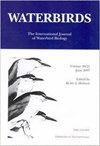Foraging Behavior of the Hawaiian Stilt (Himantopus mexicanus knudseni) at Hāmākua Marsh, O'ahu, Hawai'i
IF 0.6
4区 生物学
Q3 ORNITHOLOGY
引用次数: 1
Abstract
Understanding habitat use on a fine scale is essential for the development of management plans for threatened and endangered species. Several heavily managed State Wildlife Sanctuaries and National Wildlife Refuges provide critical foraging habitat for the endangered Hawaiian Stilt, or Ae'o (Himantopus mexicanus knudseni). The foraging behavior and habitat use of Hawaiian Stilts at Hāmākua Marsh State Wildlife Sanctuary, O'ahu, Hawai'i was investigated. Foraging tactics, success, and microhabitat were recorded for 227 birds over 24 2-hr periods from September to December 2021. Hawaiian Stilts made the most foraging attempts in shallow (< 8 cm deep) water, and had the most success in intermediate (8–15 cm deep) water. The most commonly recorded foraging tactic was pecking, while the most successful was plunging. Visual tactics were both more common and more successful than tactile. The overall foraging success rate for Hawaiian Stilts in this study was 0.16, markedly less than success rates observed by other researchers in related species. It is possible that prey in Hāmākua Marsh is either less abundant or less vulnerable to capture than in other similar habitats. Our results suggest that future habitat management for Hawaiian Stilts should prioritize areas of shallow water and further investigate food availability.夏威夷高跷(Himantopus mexicanus knudseni)在夏威夷奥胡岛Hāmākua沼泽的觅食行为
精确地了解栖息地的使用情况对于制定受威胁和濒危物种的管理计划至关重要。几个管理严格的州立野生动物保护区和国家野生动物保护区为濒临灭绝的夏威夷高跷或Ae'o (Himantopus mexicanus knudseni)提供了重要的觅食栖息地。在夏威夷奥胡岛Hāmākua沼泽州立野生动物保护区调查了夏威夷高跷的觅食行为和栖息地利用。在2021年9月至12月的24小时内,记录了227只鸟类的觅食策略、成功和微栖息地。夏威夷高跷鱼在浅水(< 8厘米深)觅食次数最多,在中水(8 - 15厘米深)觅食次数最多。记录中最常见的觅食策略是啄食,而最成功的是俯冲。视觉战术比触觉战术更常见,也更成功。在本研究中,夏威夷高跷的总体觅食成功率为0.16,明显低于其他研究人员在相关物种中观察到的成功率。与其他类似的栖息地相比,Hāmākua沼泽的猎物可能数量较少,或者不易被捕获。我们的研究结果表明,未来夏威夷高跷的栖息地管理应优先考虑浅水地区,并进一步调查食物的可用性。
本文章由计算机程序翻译,如有差异,请以英文原文为准。
求助全文
约1分钟内获得全文
求助全文
来源期刊

Waterbirds
生物-鸟类学
CiteScore
1.30
自引率
0.00%
发文量
0
审稿时长
6-12 weeks
期刊介绍:
Waterbirds is an international scientific journal of the Waterbird Society. The journal is published four times a year (March, June, September and December) and specializes in the biology, abundance, ecology, management and conservation of all waterbird species living in marine, estuarine and freshwater habitats. Waterbirds welcomes submission of scientific articles and notes containing the results of original studies worldwide, unsolicited critical commentary and reviews of appropriate topics.
 求助内容:
求助内容: 应助结果提醒方式:
应助结果提醒方式:


